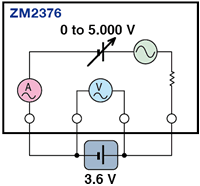

|
Measurement
of capacitor ESR using NF's
ZM-series LCR Meters
|

|
|
|

|
ESR (equivalent series resistance) is one of the parameters
that express the performance of a capacitor. In ideal
capacitors, there is only capacitance and there is no loss,
so the ESR is zero.
However, in an actual capacitor, in addition to the
capacitance, there is a resistance component due to the loss
of the dielectric and electrodes. These affect the
characteristics of the part as ESR.
Capacitors are greatly affected by ESR loss at high
frequencies and high currents. For example, if a
high-frequency ripple current flows through an electrolytic
capacitor with a large ESR, not only will it not have the
specified characteristics, but it may also be destroyed due
to temperature rise.
Therefore, ESR is often specified as a specification for
electrolytic capacitors. Since ESR changes with frequency,
it is defined as a resistance value at a certain
frequency.
ESR is measurable with NF's ZM-series LCR meters. The
secondary parameter Rs is ESR.
ESR can be measured by setting the frequency and selecting
the secondary parameter as Rs as shown in the image below.
|
|
|

|
|
|

|
Measurements
with long cables / Testing
with temperature
chambers
|

|
|
|

|
|
The ZM series has the function to correct the measurement
cable length. In the measurement examples below, the results
are nearly identical regardless of the cable being 1 m, 2 m,
or 4 m. In the test with a temperature chamber, the cable
between the measuring instrument and the sample is thin and
long, however an accurate measurement is possible.
|
|
|
Inductor measurement example (Cable length
1m, 2m, 4m)
Stable measurement is obtained
regardless of the cable length.
|

|

|
For
high-speed impedance
measurements of lithium-ion
batteries
|

|
|
|

|
The internal DC bias voltage of ZM2376 can be set up to
+5 V, enabling electromotive force of more than 3 V to be
measured in lithium-ion batteries (single cell).
In addition, since measurements can be performed from a low
frequency of 1 mHz, a detailed assessment of the internal
impedance of the battery is possible.
|

|
|